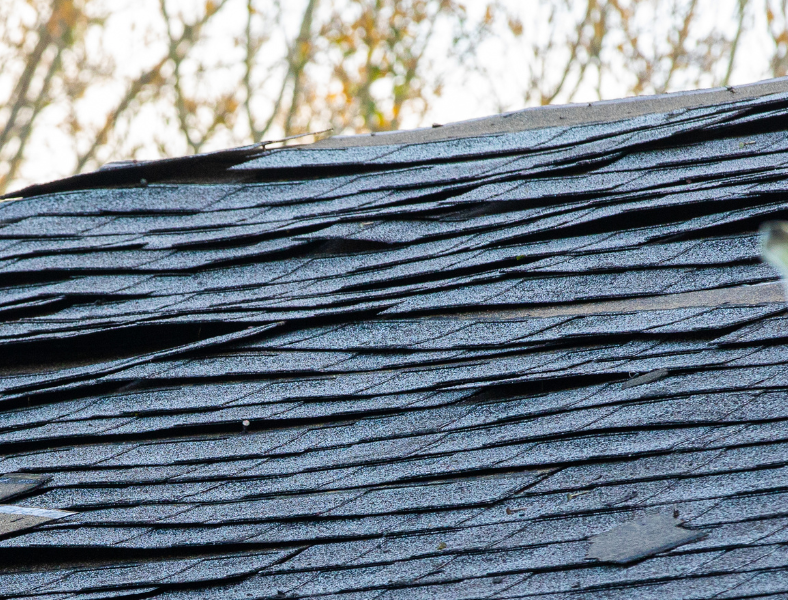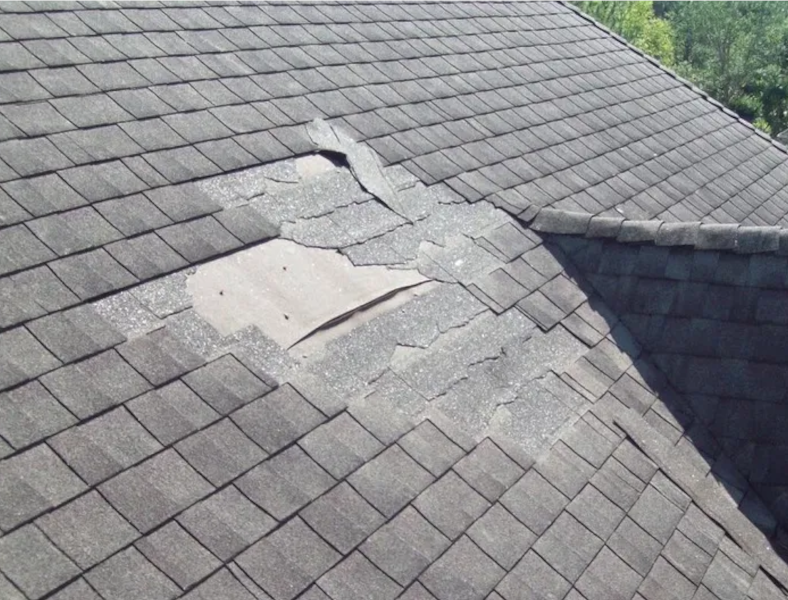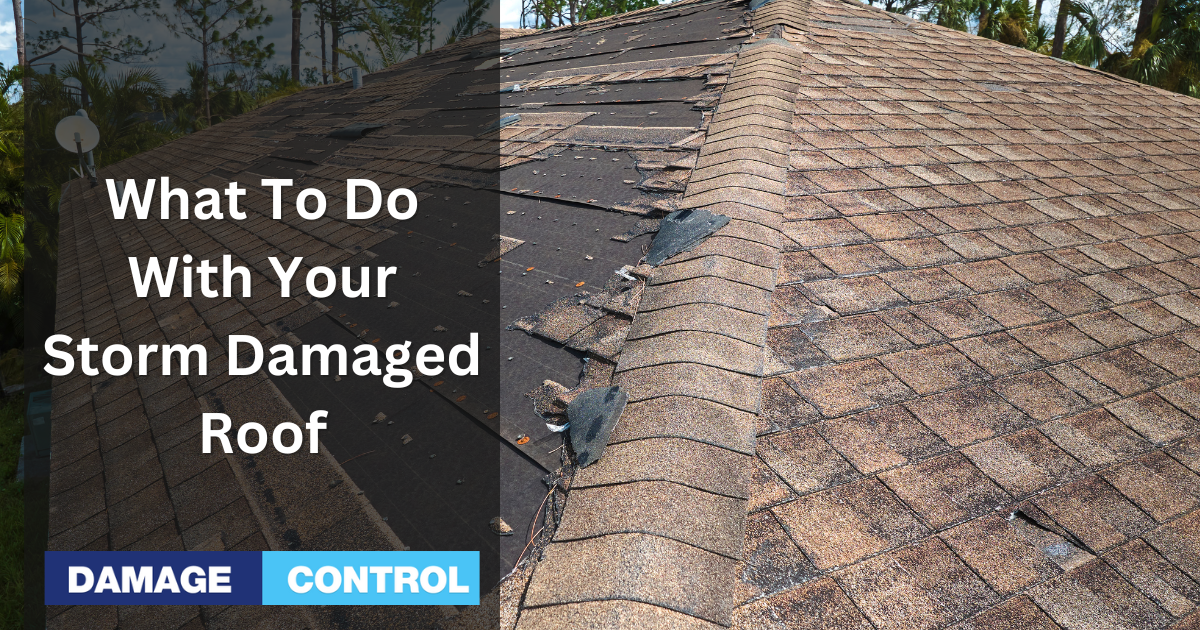Ever found yourself staring at your storm-battered roof, feeling like you're in the middle of a disaster movie? Well, you're not alone. Storm damage to roofs is no Hollywood fiction – it's as real as it gets, and it's a homeowner's nightmare.
When Mother Nature goes into a frenzy, she leaves quite a mess, and our roofs often bear the brunt of her rage. We're talking torn shingles, dented metal, smashed tiles – the works. But hey, what's a little rain or wind, right? Wrong. It's crucial to get storm damage sorted pronto.
Why, you ask? Picture this: a little leak that seems like nothing more than an annoyance suddenly causes your attic to resemble an indoor pool. Or that small patch of missing shingles leads to water seeping into your walls, leading to a mold explosion. Scary, isn't it?
So, let's buckle up and get ready to navigate this stormy sea. After all, understanding storm damage and its ramifications is the first step to fixing it and preventing future disasters. Hang tight, folks, as we embark on this journey together!
What Exactly Is Storm Damage?

Hey, storms are tough cookies, and they leave a mark. These weather bullies can deliver a real beatdown on your roof. So, let's dig deeper and dissect what storm damage really looks like.
How Does Hail Affect Your Roof?
Hail, that frozen enemy of rooftops, plays hardball. Imagine the damage a baseball team can cause if they all hit your roof at once. Yep, that's hail for you. It dents metal, cracks shingles, and chips tiles – no roof is safe when hail shows up.
What Wind Damage Can Do
Wind, a tricky devil, has its own bag of tricks. Strong gusts act like invisible hands, lifting and tearing off shingles, loosening nails, and leaving your roof vulnerable. Metal and tile aren't spared either – they can get bent or even ripped away.
The Impact of Relentless Rain
Rain may seem harmless, but let it pour long enough and it can work its way through the tiniest cracks. This water invader can sneak in, causing sneaky leaks that lead to bigger issues over time.
Do Different Roof Types Weather Storms Differently?
Absolutely! It's like picking an outfit for different weather conditions – your roof's material will determine how it reacts to a storm.
Metal Roofs and Storms
Metal roofs can take quite a hit, but not without scars. Hail leaves dents, wind causes scratches, and over time these tiny battle wounds can rust and spring leaks.
Shingles in the Storm
Shingles struggle when storms get rough. They can be torn, lifted, or even blown off completely, leaving the roof underneath naked against the elements.
Tiles and Turbulence
Tile roofs are tough guys but still vulnerable. They can crack, break, or in strong winds, can be tossed around like playing cards in a tornado.
Spotting a Storm-Damaged Roof

Identifying a storm-damaged roof is like playing detective. You've got to look for the obvious and the hidden clues.
The Tell-Tale Signs
Some signs are clear as day: missing shingles or tiles, visible holes, and leaks inside your house. You might even find a sea of shingle granules swimming in your gutters.
The Sneaky Clues
Then there are the stealthy signs that could spell big trouble down the road. Look for slightly lifted shingles (an open invitation for rain) or dented roof vents that could mess with your home's airflow. Remember, the devil's in the details!
What's Next After the Storm Hits Your Roof?
Phew! The storm's passed, but your roof took a beating. So, what now? Here's your immediate game plan.
What About Safety First?
Absolutely! Just like we buckle up before hitting the road, there are safety measures to take right after the storm.
Are You Safe?
Keep clear of any damaged areas. There might be loose debris or dangling power lines. You're not a stunt double, so avoid any unnecessary risks.
And Your Property?
Look around. If there's any immediate threat to your property, like a big tree branch teetering on your roof, call the pros to handle it. Safety first, always.
Can You Do Any Immediate Damage Control?
Definitely! You've weathered the storm, now it's time to minimize the damage.
Have you heard about emergency tarping? It's like putting a Band-Aid on a cut. Slap a tarp over the damaged area to protect it from further rain or wind. It's a temporary fix, but it'll prevent the situation from worsening.
When Should You Dial up a Pro?
If you're in over your head or there's significant damage, get on the horn pronto. Professional roofers can assess and address the situation effectively. Remember, a stitch in time saves nine, especially regarding your roof.
In the aftermath of a storm, it's all about acting swiftly and safely. Once you've done what you can, leave it to the experts. After all, no one expects you to be a superhero, just a smart homeowner!
How to Gauge the Storm's Impact on Your Roof?
The storm's done its number, and now you're left staring at your roof, wondering how bad it is. Fret not; we've got your back!
Can You Do a DIY Roof Damage Assessment?
Sure thing! Just like you'd do a self-checkup before going to the doctor, you can do a preliminary roof assessment.
What About the Outside?
Start by walking around your house. Look for any missing or damaged shingles, or even granules piled up in your gutters. But remember, no climbing up there! Leave the high-altitude inspection for the pros.
And the Inside?
Your attic is a great snitch for roof damage. Water stains, moldy smells, and even daylight peeking through the roof are all signs of trouble.
Should You Get a Professional Roof Inspection?
Absolutely! Like you'd get a pro mechanic to look under your car's hood, your roof needs a professional's trained eye.
What's in Store?
They'll do a thorough check, both inside and out. They'll spot the obvious issues and the sneaky ones too. They've got the gear, the expertise, and thankfully, the insurance to safely climb up and get the lowdown on your roof's condition.
What's the Upside?
An expert can spot things you might miss, and they can give you an estimate of the repair costs. Plus, their report can be helpful when dealing with your insurance company.
Remember, it's all about clearly understanding the storm damage. You can plan an attack once you know what you're dealing with. So, let's roll up our sleeves and get to it!
How to Tackle Insurance Companies After a Storm?

Ah, insurance companies. Navigating their policies can feel like wandering through a maze. Don't worry; we're here to help light the way.
Got a Homeowner's Insurance Policy?
Terrific! Now let's dig into the details.
Does it Cover Storm Damage?
Most policies do cover storm damage, but it's essential to know exactly what's included. Like a personalized playlist, each policy is unique, so you need to know what tunes you've got to dance to.
What About the Fine Print?
Like an allergy warning on a candy bar, your insurance policy might have some exceptions. Some policies might not cover certain types of damage or only pay for a portion of the repair costs. So, make sure you read it carefully!
Ready to File an Insurance Claim?
Hold on to your hats, folks, we're diving in!
How to Document the Damage?
Take photos and notes of all the damage. The more detail, the better. Consider it gathering evidence for a detective case – your insurance company will need it to process your claim.
What About the Claims Process?
Start by contacting your insurance company to report the damage. They'll guide you through the process, which usually involves filling out forms and providing your documentation. They may send an adjuster to inspect the damage or use the report from your professional roofer.
Remember, when dealing with insurance companies, knowledge is power. Understand your policy, document everything, and stay organized. It might seem like a lot, but hey, that's why we're here – to help you navigate the stormy seas of insurance claims. Let's keep going!
Ready to Kickstart the Repair Process?
Alright, time to roll up our sleeves and get your roof back in shape. But first, you've got some decisions to make.
How to Find a Trustworthy Roofing Contractor?
Think of this like picking a movie – you want quality, reliability, and a happy ending.
What Makes a Good Contractor?
Start with their reputation. Check out reviews and ask for recommendations. Then, confirm they're licensed and insured – you don't want any surprises. And finally, compare quotes from a few contractors to ensure you're getting a fair deal.
Any Red Flags to Watch Out For?
Be wary of contractors who pressure you into signing a contract immediately or ask for full payment upfront. And if their quote seems too good to be true, it probably is.
How About Understanding Repair Options and Costs?
Your roof is like a jigsaw puzzle – the type of repair depends on the missing pieces.
What if It's Just a Few Minor Repairs?
If you've only lost a few shingles, patching might do the trick. It's like putting a patch on jeans – quick, easy, and cost-effective.
And for Major Repairs?
Sometimes, the storm damage is more extensive, and you need more than just a patch job. Major repairs can include replacing large sections of your roof or fixing underlying structural damage.
What About a Full Roof Replacement?
If your roof's been really beaten up or older than your grandma's rocking chair, it might be time for a complete replacement. It's a big job, but sometimes it's the best option to protect your home in the long run.
Remember, this isn't a DIY project. Finding a reliable contractor and understanding your repair options is crucial. But don't worry, you've got this!
How to Ward Off Future Storm Damage?
We've patched things up, but how about keeping future storms at bay? Let's turn your roof into a storm-resistant fortress!
Got Any Roof Maintenance Tips?
Maintenance is like brushing your teeth regularly to prevent bigger problems.
How Often Should You Inspect and Clean Your Roof?
Like your annual doctor's check-up, your roof needs a yearly look-see. Keep those gutters clean and free of debris. Trust me, your roof will thank you!
Should You Address Minor Repairs Promptly?
Absolutely! Think of small issues like loose shingles as tiny leaks in a boat. Ignore them, and you might find yourself sinking.
How About Upgrading Your Roof to Weather the Storms?
Think of this as an insurance policy for your roof.
Can You Reinforce Your Roof?
Sure can! Consider adding a roof brace or installing hurricane straps. It's like giving your roof a set of boxing gloves to fend off the storm.
What About Storm-Resistant Roofing Materials?
There are plenty of durable options out there. You can choose materials designed to withstand Mother Nature's temper tantrums from metal roofing to impact-resistant shingles.
Preventing storm damage is all about proactive care and smart upgrades. After all, a stitch in time saves nine, right? So, let's keep your roof in tip-top shape and ready to face whatever the weather throws!
Frequently Asked Questions (FAQs)
How do I know if my roof is damaged from a storm?
Signs of storm damage can include missing or damaged shingles, granules in your gutters, or leaks in your attic. If you're unsure, getting a professional inspection is best.
Can I repair storm damage myself?
It depends on the extent of the damage. Minor repairs like replacing a few shingles might be doable, but it's often best to leave the work to the pros for safety reasons.
How long can I wait to repair a storm-damaged roof?
It's best not to wait. Even minor damage can worsen, leading to leaks and structural damage. The sooner you address the damage, the better.
How much does it cost to repair a storm-damaged roof?
The cost varies depending on the extent of the damage and the type of repair needed. A small repair might cost a few hundred dollars, while a roof replacement can cost thousands. It's best to get quotes from several contractors for an accurate estimate.
Will my insurance cover storm roof damage?
Most homeowner's insurance policies cover storm damage, but checking your specific policy for details is crucial. Keep in mind there may be limitations or exclusions.
What should I look for in a roofing contractor?
Look for a contractor with a good reputation, valid licensing and insurance, and a fair quote. Avoid those who pressure you into signing a contract immediately or ask for full payment upfront. Remember, if a deal seems too good to be true, it probably is.
Conclusion
And there you have it, folks. The lowdown on dealing with storm-damaged roofs. From understanding the damage and tackling the aftermath to future-proofing your roof, it's all about being prepared and prompt in action. Remember, a well-maintained roof is your first defense against the elements. Keep it in top shape, keeping you safe and dry.
After the storm, you may be looking to give your roof a makeover after the storm damage. While you're at it, consider giving it a good scrub. Our guide to pressure washing your roof can help you do it right.
For those in colder climates dealing with the icy menace, our Ice Dams and Your Roof? A Complete Guide will steer you clear of potential roof damage.
And, if the worst does happen, we've covered you with the top-rated company in Orlando. We're here to help get your home back to its best. A detailed analysis is the first step many Orlando homeowners take when they suspect a mold issue.
Storm damage isn't the end of the world. With the right knowledge, elbow grease, and professional help, your roof can bounce back stronger than ever. Now, let's get out there and weather the storm together!

